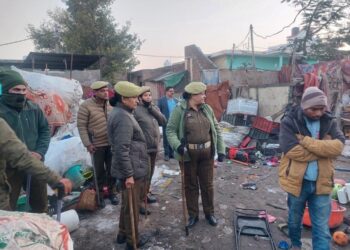NEW DELHI: In a sign of deteriorating ties with Pakistan, India has fast-tracked hydropower projects worth Rs 1,500 crores ($15 billion) in Jammu & Kashmir in recent months, ignoring warnings from Islamabad that power stations on rivers flowing into Pakistan will disrupt water supplies.
The major hydropower projects in Kashmir which have been awaiting clearances for over a decade have been swiftly approved. The approvals for at least six projects have been fast-tracked by the Indian govt as a tactical move to cripple Pakistan of the Indus waters which flow through the region.
As reported by Reuters, a top-ranked official in power ministry, Pradeep Kumar Pujari said that, I say the way you look at these projects, it is not purely a hydro project. Broaden it to a strategic water management, border management problem, and then you put in money. The projects that have won technical approvals in recent months are Sawalkote, Kwar, Pakal Dul, Bursar and Kirthai I and II.
Pakistan has opposed some of these projects before, saying they violate a World Bank-mediated Indus Waters Treaty on the sharing of the Indus River and its tributaries upon which 80% of its irrigated agriculture depends.
The schemes, the largest of which is the 1,856 MW Sawalkote plant, will take years to complete, but their approval could prove a flashpoint between the nuclear-armed neighbours at a time when relations are at low ebb.
Pakistans Foreign Ministry spokesperson Nafees Zakaria said he would confer with the Ministry of Water and Power on the proposed Indian projects, saying it was a technical matter.
He noted, however, that India would be attending a regular meeting of the Indus Commission later this month in Lahore, even though the broader peace dialogue was on hold.
It seems that finally India has realised the importance of this mechanism under the IWT (Indus Waters Treaty) for resolving water disputes related to the Indus water and its tributaries.
Triple power
Six hydro projects in Jammu & Kashmir either cleared viability tests or the more advanced environment and forest expert approvals in the last three months, two officials in Indias Water Resources Ministry and the Central Electricity Authority said separately, according to the Reuters report.
Together these projects on the Chenab River, a tributary of the Indus, would triple hydropower generation in Kashmir from the current level of 3,000 MW, the biggest jump in decades, added the officials, declining to be named because the approvals had not yet been made public.
We have developed barely one-sixth of the hydropower capacity potential in the state in the last 50 years, the senior official at the Water Resources Ministry said.
Then one fine morning, you see we cleared six to seven projects in three months; it definitely raises concern in Pakistan.
Pakistans water supply is dwindling because of climate change, outdated farming techniques and an exploding population.
A 2011 report by the US Senate Committee on Foreign Relations said New Delhi could use these projects as a way to control Pakistans supplies from the Indus, seen as its jugular vein. The cumulative effect of these projects could give India the ability to store enough water to limit the supply to Pakistan at crucial moments in the growing season, it said.
India says the projects are run-of-the-river schemes that use the rivers flow and elevation to generate electricity rather than large reservoirs, and do not contravene the treaty.
Environmental groups have questioned whether the government has followed proper procedures in fast-tracking projects located in a highly seismic area.
Blood and water
Modi told a meeting of government officials on the Indus treaty in 2016 that blood and water cannot flow together, soon after India blamed Pakistan-based militants for a deadly attack on its troops in Kashmir.
Modis message was two-fold, foreign ministry spokesperson Gopal Baglay said. Terrorism had to stop and India must fully utilise the economic potential available to it within the Indus treaty.
The projects that have won technical approvals in recent months are Sawalkote, Kwar, Pakal Dul, Bursar and Kirthai I and II.
Most of the projects have been held up for at least a decade awaiting multiple clearances. Sawalkote, which was cleared by a government-constituted environment committee in January, was first given techno-economic approval in 1991.
It is now up for forest clearance from the state authorities, after which the government will finalise financing and begin construction.
Some projects like Pakal Dul were stuck in litigation, but that has been resolved, J&K Power Minister said. Things are now in a position of take-off, he added.
In January, senior Indian officials made a presentation on energy security to Modi in which they proposed interest subsidies and long-term loans for hydroprojects above 100 MW, according to an official document.
But Himanshu Thakkar, coordinator of South Asia Network on Dams, Rivers and People, said some projects had been cleared without impact assessment studies and public consultation.
Its on one river, the Chenab, where you are doing so many projects. This is a very vulnerable region. Its landslide-prone, its flash flood-prone, earthquake-prone.
Follow this link to join our WhatsApp group: Join Now
Be Part of Quality Journalism |
Quality journalism takes a lot of time, money and hard work to produce and despite all the hardships we still do it. Our reporters and editors are working overtime in Kashmir and beyond to cover what you care about, break big stories, and expose injustices that can change lives. Today more people are reading Kashmir Observer than ever, but only a handful are paying while advertising revenues are falling fast. |
| ACT NOW |
| MONTHLY | Rs 100 | |
| YEARLY | Rs 1000 | |
| LIFETIME | Rs 10000 | |








